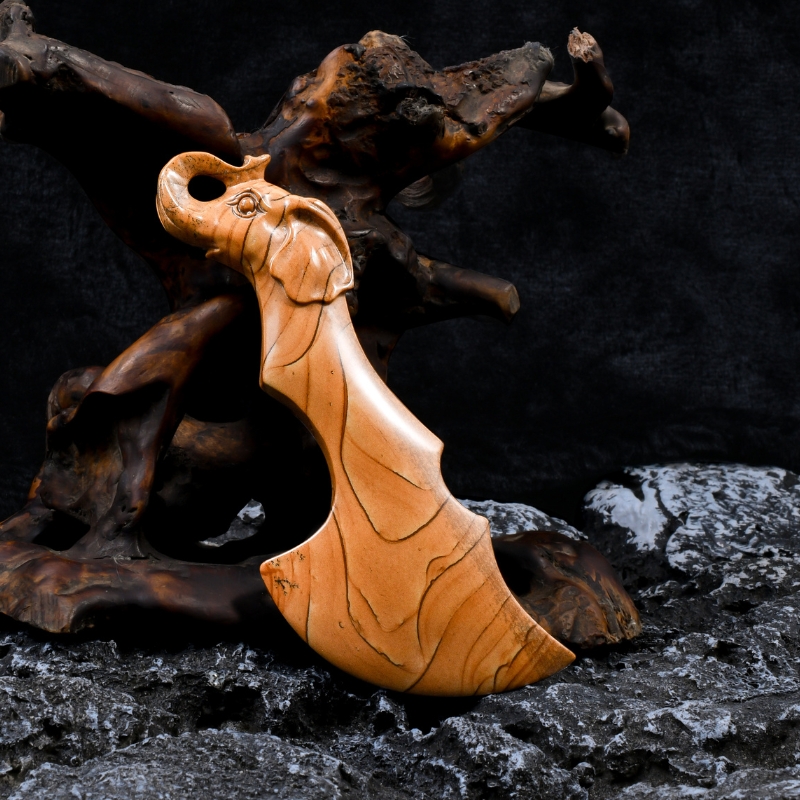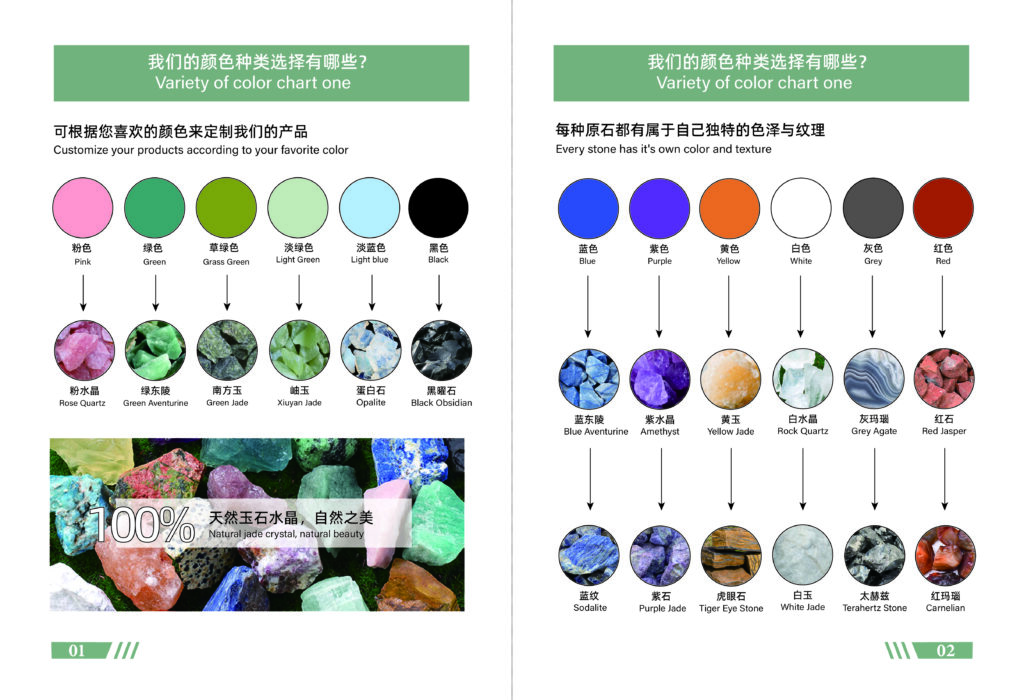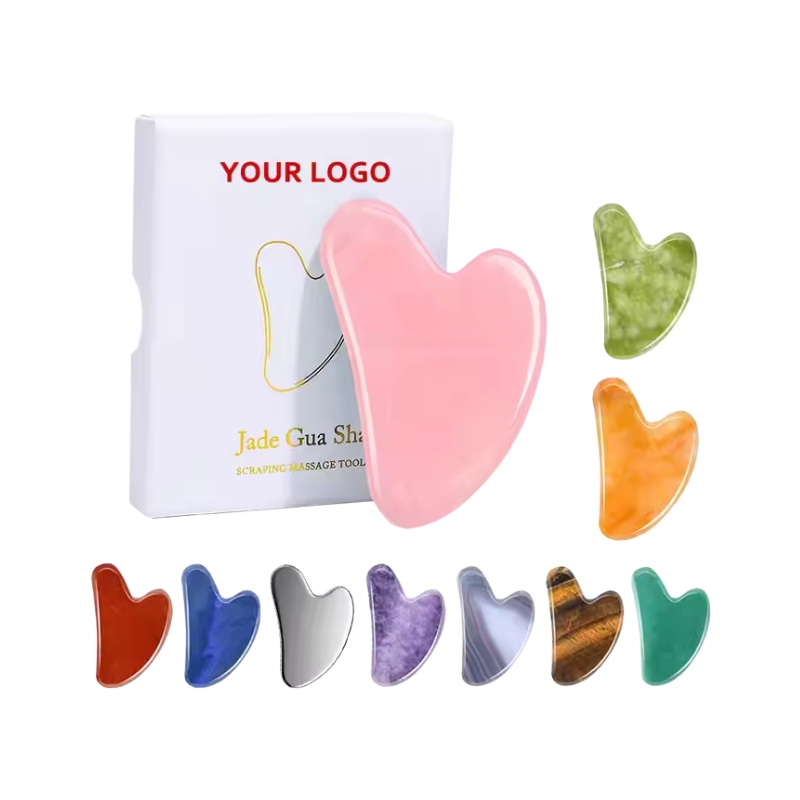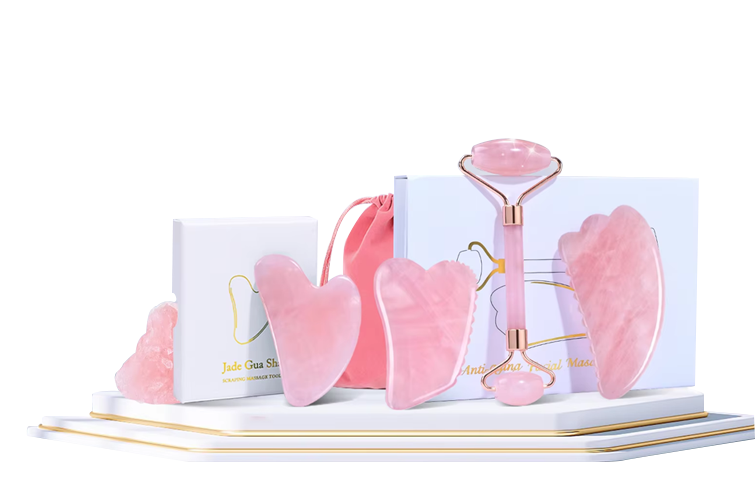Deyi Gem Co., Ltd. is the second largest gua sha stone manufacturer in China. Deyi Gem has more than 50 years of experience in the jade and crystal industry. It is also a professional supplier of gua sha tools, rollers, and massage tools. Deyi Gem can analyze your design and requirements from multiple dimensions to assist you in customizing and selecting various crystal and jade products. We provide services in many aspects, such as raw material traceability, color, material, product quality identification, inspection, and packaging design. This ensures that you have a comprehensive understanding of the production guidelines and quality standards for gua sha stones and other products. For more information or a quote for your next project, please contact us.
What is a gua sha stone?

Gua Sha stones are a common tool used in traditional Chinese medicine for Gua Sha therapy. They are usually made of natural jade, crystal, ox horn, and stone. In traditional Chinese medicine, Gua Sha stones are used to repeatedly scrape specific areas of the skin to promote blood circulation, relieve pain, and regulate the body.
At Deyi Gem Co., Ltd., we can assist you in customizing scraping stones. We offer a wide range of options, including different materials, colors, shapes, and packaging, to help you create customized scraping stones. We help you achieve systematic and stable production of natural scraping stones, enhancing the stability of your products and your brand’s competitiveness.
History of the gua sha stone
It is said that the origin of scraping stones can be traced back to ancient times, when people used sharp stones to cut swollen areas, perform bloodletting, and scrape the body. During the Qin and Han dynasties, approximately 2,000 years ago, people would use jade stones to rub or tap certain areas of the body’s surface when ill or injured, which helped alleviate pain. This method gradually evolved into the rudimentary form of scraping stone therapy. Until the Yuan Dynasty 650 years ago, copper coins and porcelain spoons dipped in oil were used to scrape the back to relieve symptoms. In modern times, jade and crystal materials have been widely used due to their smooth surface and ergonomic design. Jade and crystal Gua Sha tools add value to gua sha massage tools. They are also more durable and healthier.
What colors are gua sha stone available in?

Regular gua sha stone only seven colors are red, yellow, blue, green, purple, white, black. There are other colors too, but the materials are harder to find. For example, the color of Xiu Jade is very beautiful, but in the European and American markets, people prefer crystal, and they love pink crystal and amethyst. Colors are not as bright or as pure as they should be, and there are cases worldwide where resins are used to match colors to natural minerals. There are also stones washed in acidic solutions that are passed off as natural jade and crystals. Natural jade and crystal colors are comforting, not stunning. It is a color judgment that belongs only to human beings in terms of aesthetics, and while children may be attracted to stunning and bold colors, it is the comforting colors brought about by the beauty of nature that people ultimately choose. Whatever the seven colors may bring, they can contribute to your health.
Are the 3 most effective Gua Sha Stone natural?
Make your judgment based on three factors: color, weight, and texture. The colors of natural minerals are not very vivid. If the color is very pure and eye-catching, it is most likely fake. Gem dealers and auction houses will not give you the opportunity to find they. The more expensive the material, the more scammers there are. Weight is easy to test. Natural minerals are generally not very light. If you feel that it is too light, it is likely a resin-made scraping stone. If it is made of resin, it must be at least food grade to be suitable for scraping, because it is used in contact with the skin. Long-term use is definitely unhealthy. Food-grade injection molding is not cost-effective for this product, and the price and profit are unstable. Therefore, when buying a resin Gua Sha tool, you need to weigh it yourself. The feel refers to the smoothness and roughness of the surface. Natural mineral stones will inevitably have small natural pits and cracks on the surface. When you touch jade or crystal, they feel very textured, similar to touching high-quality ceramics.
What are the materials used for gua sha stones?

There are at least 70 types of natural minerals that can be used to make gua sha stones, but only 17 are suitable for large-scale customization: rose quartz, green aventurine, green jade, xiu jade, opal, obsidian, blue stone, blue aventurine, amethyst, purple stone, topaz, tiger’s eye, white crystal, white jade, gray agate, red stone, and red agate. Different materials have different advantages. However, only these materials can guarantee consistent quality for large-scale customization. Other materials either have inconsistent quality or experience significant price fluctuations, leading to unstable production costs.
Gua sha stone, how is it tested?
The only standard tests are collision and drop tests. Honestly, when the Mohs hardness is the same, it’s completely up to luck which one breaks when dropped. These tests have no reference value whatsoever, yet they are considered reasonable. Are there any material testing reports? Have the Gua Sha tools been tested in actual use? Can the designed products withstand 10,000 scratches?
So when Deyi Gem is questioned about its quality, I’m always shocked, because some of the designs are so absurd—have they really been tested in actual massage parlors? Scraping stones that hurt the hands can be designed—sometimes I find it hard to believe. The customers enjoying the scraping are our customers, but the massage therapists using the scraping stones aren’t our customers? I don’t understand—they’re all our customers, yet some designs are clearly targeted at the market or designed to avoid patents, resulting in useless products. We have long-term partnerships with multiple massage parlors, and our products are tested by us over an extended period. We conduct durability tests, transportation impact tests, and actual functionality tests. Additionally, our materials can be traced back to their origin to verify their source.
What are the packaging options for gua sha stones?

Deyi Gem Co., Ltd. provides ODM services and has rich experience in packaging design. We offer conventional packaging and multiple gift box designs, as well as resin box packaging, gift box packaging, and many other packaging services.
What kind of physical therapy can be done with gua sha stones?
Traditionally, physical therapy has primarily focused on promoting local blood circulation. By scraping the skin, it stimulates the dilation of capillaries, increases local blood flow, and alleviates tissue hypoxia. This helps relieve fatigue. Additionally, scraping the muscles and fascia can alleviate muscle pain and tension. It is particularly effective for relieving muscle soreness after prolonged sitting or exercise. It also promotes metabolism and helps reduce mild edema.
However, certain individuals should avoid scraping therapy, including those with skin ulcers, inflammation, or infections, as well as those who are physically weak or elderly.
What part of the body needs a gua sha stone?
The most commonly used areas for gua sha stones are the sides of the spine on the back, the neck and shoulders, the limbs, and the face. It is important to note the following: Gua sha on the back primarily regulates internal organ functions and alleviates respiratory discomfort. It should be performed along the spine from top to bottom in a single direction, avoiding the protruding areas of the spine. Gua sha on the neck and shoulders primarily helps relieve muscle stiffness, neck stiffness, headaches, or neck and shoulder strain. Gently scrape from the neck toward the outer side of the shoulders, avoiding direct pressure on the cervical vertebrae; facial scraping promotes blood circulation and reduces swelling. The technique should be extremely gentle to avoid pulling the skin. Scrape slowly from the lower jaw, along the cheekbones, to the area in front of the ears.
Who can use gua sha stone?
Most sub-healthy people are suitable for using Gua Sha stone:Sedentary people, chronic fatigue people and mild edema people are suitable for using Gua Sha stone.Mild pain and discomfort of the crowd, namely pillow, headache, back pain or joint stiffness of the people are suitable for the use of Gua Sha stone.
Beauty and health needs of people, is also suitable for the use of Gua Sha stone. Patients with qi stagnation and blood stasis after diagnosis by Chinese medicine practitioners are suitable for treatment with Gua Sha stone.
There are also some contraindications of the crowd is not suitable for the use of gua sha stone: skin abnormalities, coagulation dysfunction, special physiological state of the person, serious chronic disease patients, frail, old age and so on.

